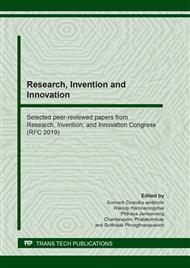p.317
p.323
p.331
p.339
p.347
p.354
p.360
p.367
p.376
Effect of Plastic and Tire Wastes on Marshall Properties, Density and Water Absorption of Polymer Pavement
Abstract:
The amount of plastic wastes and tire wastes were continuously increasing. The old tires and polymer which was low-density polyethylene (LDPE) were used to create polymer-modified pavement to get rid of plastic wastes and tire wastes replacing asphalt road. LDPE of 15 wt% was the main matrix material of the modified road pavement instead of asphalt; moreover, ground tire rubber (GTR) at various concentration of 3, 5, 7 and 10 phr was used as the additive mixed with mineral aggregates of 85 wt%. In this study, the Marshall method was used to prepare the sample. The properties of Marshall stability, Marshall flow, bulk specific gravity and voids of the polymer-modified pavement were studied for comparing to commercial asphalts. The results showed that the strength of the modified pavement increased which was higher than commercial asphalts although void concentration increased. The bulk specific gravity decreased as increasing amount of GTR. The percentage of water absorption increased as addition of GTR content. This study might be benefits in reduction of waste and valuable resources as bitumen, and also recovery an environment
Info:
Periodical:
Pages:
347-353
Citation:
Online since:
August 2020
Price:
Сopyright:
© 2020 Trans Tech Publications Ltd. All Rights Reserved
Share:
Citation:


